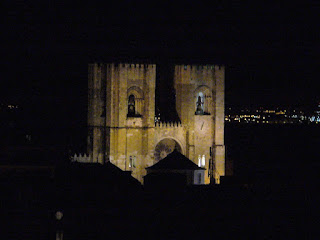
Portuguese sailors discovered an eastern route to India via the Cape of Good Hope during a period that became known as the Age of Discoveries (1415-1499). Portugal, then a nation of fewer than two million people, eventually held sway over a staggering collection of colonies in Brazil, Africa, India, and Southeast Asia.
Enduring symbols of the wealth that subsequently flooded the nation are visible today, as is the eventual decay that followed. This juxtaposition is my most poignant memory of Lisbon, having just returned from five days of work. This was my first trip to Portugal. I think I'm up to 47 countries now, excluding those nations I've only visited for minutes.
Most of the time we were holed up in our hotel, but did get to explore the city on a few occasions. The first was a walking tour of the city one evening. We explored some of Lisbon's oldest areas. Much of what we saw was built after devastating earthquakes in 1531 and 1755.
The heart of the city is the Baxia or city centre. The Baixa is organised in a grid system and a network of squares built after 1755. The Castle of Sao Jorge and the Lisbon Cathedral are located on one of the surrounding hills. Both venues were floodlit making for a stunning city backdrop.
The tower is 45 meters high and has two elevator booths, with wooden interiors. The highest level is reached by spiraling cast iron staircases. These lead to a terrace with a wonderful view of Lisbon. Our group stopped to sample a local beer, effectively taking over this scenic spot for half an hour. We also stopped to sample the famous "Moscatel" wine from nearby Setúbal. It's similar to a sweet sherry.
After our walking tour, we stopped for dinner at a local Fado restaurant. Fado (translated as destiny or fate) is a music tradition that dates back to the early 1800s. As the translation suggests, Fado is ideal mood music for slashing your wrists. It conveys a complex mixture of nostalgia, tinged with sadness, pain, happiness, and tragic love. Our restaurant kindly switched to dim red lighting as each singer ventured onto the stage, making us quietly chuckle every time.
Our final night in Lisbon was also spent in town, dining outdoors at a small cafe. We sat on a cobblestone street with views down a narrow lane and across the city toward its floodlit castle. All in all a most memorable meal.
I finally got to spend several hours wandering the city in daylight on Sunday afternoon before heading off to the airport. I wandered down to the harbour's edge where the Praça do Comércio is located. This magnificent plaza marks the beginning of Lisboa's downtown, framing the city with a grand arch.
From here I walked the cobbled streets, dodging old, classic trams eventually reaching the city's twin-towered cathedral. I then climbed the hill to the Castle of Sao Jorge. The view was stunning. Lisbon is a sea of red-tiled roofs and white-walled buildings.
I then wandered back to the metro station via the steep lanes and stairways of the old neighborhood of Alfama. Here the building is decorated by fading, chipped ceramic tiles in a variety of colours and designs. Without a doubt, Lisbon has plenty of character!












1 comment:
Thanks Andrew, Very interesting and great photos!
Post a Comment